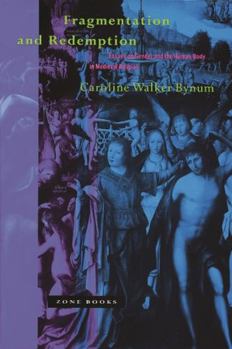Fragmentation and Redemption: Essays on Gender and the Human Body in Medieval Religion
Select Format
Select Condition 
Book Overview
Fragmentation and Redemption is first of all about bodies and the relationship of part to whole in the high Middle Ages, a period in which the overcoming of partition and putrefaction was the very... This description may be from another edition of this product.
Format:Hardcover
Language:English
ISBN:0942299639
ISBN13:9780942299632
Release Date:November 1990
Publisher:Zone Books
Length:432 Pages
Weight:1.70 lbs.
Dimensions:1.5" x 6.0" x 9.0"
Age Range:18 years and up
Grade Range:Postsecondary and higher
Customer Reviews
2 ratings
Cultural analysis v. social scientific method of medieval religiosity
Published by Thriftbooks.com User , 15 years ago
In Fragmentation and Redemption, Carolyn Bynum refutes modern misconceptions about spirituality and symbols in the European Middle Ages. More importantly and relevant to her book, she addresses misinterpretations of female spirituality in the same period. The author faults some of the models of prominent modern social scientists, arguing that they are not suitable to explain the content of religious symbols of this time. Bynum instead counters this trends with an in-depth analysis of the cultural setting from which these symbols and spirituality emerged. Bynum also argues that the female aspect of spirituality has not been taken seriously and studied properly, thus giving rise to speculations and methods of analyses that do not elucidate properly about the experience of religious women in the late medieval period. First, Bynum makes a critique of the application of Victor Turner's theory of liminality to the analysis of women spirituality of the late Middle Ages. Bynum specifically questions Turner's social drama analysis of narrative and ritual experience. According to Turner's theory, there is a phenomenon called liminality--the reversal or elevation of roles at the ritual level of a human's religious experience. Bynum cites the medieval texts about the lives of female saints and finds that liminality was not central to female spirituality. The term is applicable for male spirituality, because reversal of roles was a way to emphasize their rupture with wealth and status, and in general, to criticize the male-dominated established order. Men like Francis of Assisi took vows of poverty and often identified themselves in female terms. In this instance, Turner's theory of liminality applies to the study of male spirituality. Female religious experience was different. When there was reversal of roles, according to what we can discern from the saints' biographers, it was for purely practical reasons. Such reversals were not central to women's spirituality, Bynum maintains. This is best illustrated by the "dominant symbols" of women during their experiences. If we look at female mystics such as Margery Kempe, Gertrude of Helfta, Hadewijch, or Beatrice of Nazareth, medieval women who wrote their stories, we find that the dominant symbols were Eucharistic miracles, fasting, virginity, roles of mothers, and even of lovers of Christ. These were themes that reflected their role in society (i.e. food, nurturing, motherhood, etc.), according to Bynum. Continuity--association with and identification of women's societal roles in visions, miracles, and other mystical experiences--was the norm in women spirituality. Bynum refutes Turner's notion that women, because of their inferior status in medieval Europe, assumed roles of empowerment in that society, that is, of male figures. He assumes a supposed "symmetry" in the liminalities of both sexes, according to Bynum. Women were liminal to men, but not the other way around. The purpose of role reversal for men
"Love and Inestimable Satiety"
Published by Thriftbooks.com User , 23 years ago
Fragmentation and Redemption is a series of seven essays spanning the topics of gender, religious relics, sex, mortality, gender and the miraculous. The essays and the accompanying images are graphic and unforgettable. For example; "The ill clamored for the bathwater of would-be saints to drink or bathe in and preferred it if these would-be saints left skin and lice floating in the water." If you are interested in the cult of relics and medieval mysticism then this book will be a valuable resource. Ecstatic, erotic medieval religious frenzy are chronicled in detail in the highly readable and lively text. I find myself returning to these essays over and over again as I read other, more specific, books on western medieval religious traditions. This is a must have for your reference desk.





